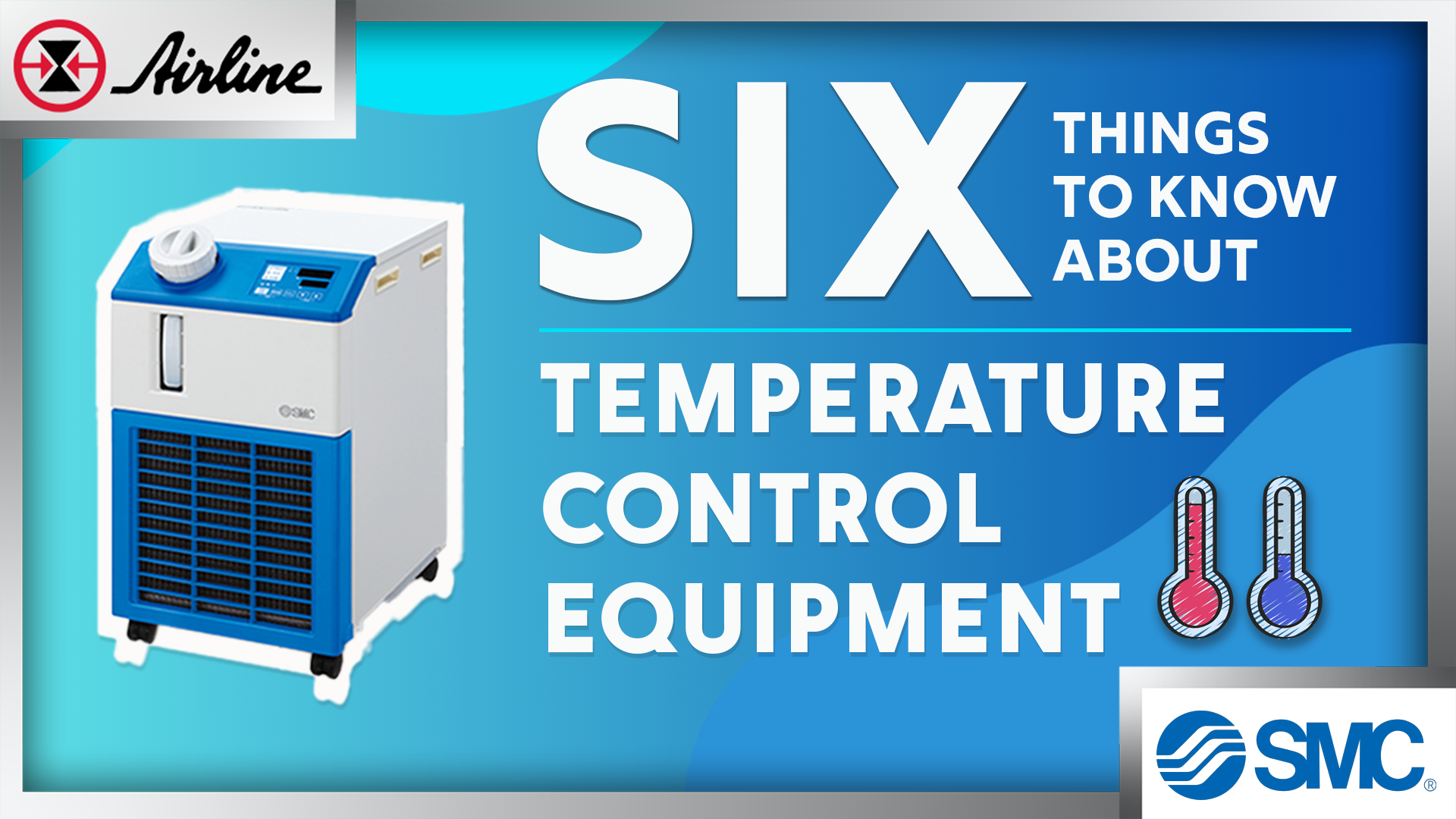Ever wonder how industries maintain precise temperatures during critical processes? Whether it's keeping chemical reactions stable, ensuring product quality, or preventing equipment from overheating, temperature control equipment plays a vital role behind the scenes.
Think of chillers, temperature controllers, and heat exchangers as the guardians constantly adjusting and fine-tuning to keep operations running efficiently. But this isn’t just about keeping things cool; it’s about safeguarding your processes and ensuring consistency across the board.
In this post, we’ll review six key things you need to know about temperature control equipment—and how it can be a game-changer for your business.
Skip to a Section
Understanding Temperature Control Equipment | Importance of Temperature Control in Industry-Specific Settings | Common Types | Benefits | How to Choose the Right Temperature Control System for Your Project | Installation and Maintenance Tips for Chillers | The Future of Temperature Control Technology | Frequently Aske Questions
Understanding Temperature Control Equipment
What is Temperature Control Equipment?
At its core, temperature control equipment is designed to regulate and maintain the desired temperature of machines, processes, or environments within industrial settings. Whether the goal is to heat, cool, or maintain a specific temperature, these systems ensure operations run smoothly and efficiently.
How Does it Work?
Temperature control equipment operates by using sensors and controllers to monitor the current temperature and adjust it as needed to meet a set point. Heat is transferred by a circulating fluid and a refrigeration cycle, facility water, or Peltier device. This closed-loop system continually measures the output and makes necessary adjustments to maintain the desired temperature.
1. Importance of Temperature Control in Industry-Specific Settings
In industries like life science, food production, and electronics, precise temperature control is non-negotiable. Temperature control technology ensures product quality, safety, and compliance with stringent industry regulations. Let's explore why temperature control is so crucial.

Precision in Manufacturing
In sectors like plastics and metal processing, temperature control is critical for achieving the desired material properties. Inconsistent temperatures can lead to defects, compromising product quality and increasing waste. For other manufacturing processes, this technology is used for process control, quality assurance, and product testing.

Safety and Compliance
In the food and beverage industry, maintaining the correct temperature during processing and storage is essential to prevent spoilage and ensure consumer safety. Similarly, in healthcare, precise temperature control is vital for equipment like incubators and autoclaves.
![]()
Energy Efficiency
Proper temperature control optimizes energy use, reducing operational costs. By maintaining consistent temperatures, equipment functions more efficiently, extending its lifespan and minimizing maintenance demands.
2. Common Types of Industrial Temperature Control Equipment
Industrial temperature control equipment comes in various forms, each suited for specific needs. Here’s a look at some common types:
 Chillers
Chillers
Chillers play a pivotal role in cooling processes. By using a closed-loop refrigeration cycle, they remove heat from a fluid circulating between the device and a heat source, ensuring they remain at the desired temperature. Widely used in industries such as semiconductor manufacturing and medical devices, chillers are indispensable for operations requiring precise thermal management.
|
With the Chiller Sample Evaluation Program, customers can test SMC's available models in their facility before committing to a purchase. This program ensures that the chiller meets all operational needs, giving you the confidence to make the right decision with zero risk. Try today! |

Circulating Baths
Circulating immersive baths are ideal for laboratory settings. They maintain a constant temperature over extended periods. Frequently used in chemical research and biological studies, these systems ensure accurate and consistent experimental results without manual intervention.

Heat Exchangers
These devices transfer heat between two fluids without mixing them, making them perfect for processes needing heating or cooling. Unlike a chiller, a heat exchanger does not employ a refrigeration circuit, making it energy-saving and refrigerant-free. Heat exchangers are commonly used in power plants, oil refineries, and food processing.

Temperature Controllers
Temperature controllers are vital components in many industrial processes, providing the necessary automation to maintain the desired temperature setpoint. These devices monitor temperature through sensors and adjust heating or cooling elements as needed to achieve the targeted conditions. Utilized in various applications, from industrial ovens to extrusion processes, temperature controllers enhance operational efficiency by preventing fluctuations that could lead to quality issues or equipment malfunction.
3. Benefits of Temperature Control Equipment
Implementing temperature control equipment in industrial settings offers numerous benefits:
Enhanced Efficiency
By keeping equipment at optimal temperatures, these systems improve operational efficiency, reducing unplanned downtime and energy consumption.
Safety Assurance
Temperature fluctuations can pose safety hazards, such as equipment failures or chemical reactions. Maintaining stable temperatures prevents these hazards and minimizes risks associated with overheating or overcooling.
Cost Savings
Efficient temperature regulation reduces energy bills and extends equipment life, resulting in substantial cost savings over time.
4. How to Choose the Right Temperature Control System for Your Project
Selecting the correct component for your project involves evaluating key features to meet your specific needs. Cooling capacity, temperature control, energy efficiency, and compact design are critical factors to consider.
Selecting the appropriate temperature control system can be daunting. Here’s a guide to help you make an informed decision:
1. Assess Your Needs
Consider the specific requirements of your application. Will you need heating, cooling, or both? Identify the desired temperature range and precision required.
2. Evaluate System Features
Look for systems with features tailored to your needs. Consider factors such as energy efficiency, ease of integration, and maintenance requirements.
3. Consult Experts
Engage with industry professionals to gain insights into the latest technologies and best practices. Their expertise can help you identify the most suitable solution for your application. At Airline, we have automation and control experts ready to answer your questions, help with specification and configuration, and so much more. Contact your local Airline sales representative for support. New to Airline? Contact our customer service team, who will connect you with one of our experts.
5. Installation and Maintenance Tips for Chillers

Chillers, a popular type of temperature control equipment, are essential when precise temperature control of a machine or process is required. A refrigeration system absorbs heat from a recirculating liquid through either a vapor-compression or absorption cycle. But knowing you need a chiller is only half the battle—how do you deploy one in your facility?
Here’s a quick guide to help. When installing a chiller, consider key factors like site preparation, stability, and proper coolant line connections. These elements ensure your chiller operates smoothly in your specific environment. The good news? Modern chillers are built for easy maintenance—they’re designed to be user-friendly and efficient, helping you keep downtime to a minimum.
Let’s explore some essential installation practices and maintenance tips to ensure your chiller operates at its best.
Proper Installation Tips
A clean, level installation site with good ventilation and a reliable power supply is essential. Optimizing the surrounding environment’s temperature and humidity prevents strain on the chiller’s components and ensures efficient operation.
Securely positioning the chiller in its designated location maintains stability and prevents potential hazards. Proper site preparation and attention to environmental conditions enhance the performance and lifespan of your chiller.
Routine Maintenance and Troubleshooting
Regularly checking and maintaining the coolant level prevents potential pump damage. Periodically lubricating the pump avoids permanent damage from running dry and ensures smooth operation.
Monthly inspection and cleaning of water filters prevent buildup that affects performance. Periodically replacing the coolant fluid ensures optimal operation. Monitoring for leaks and following the manufacturer’s guidelines for electrical connections maintain efficiency and prevent issues.
6. The Future of Temperature Control Technology
One of the most exciting developments driving this change is the rise of IoT (Internet of Things) and smart systems. These technologies not only enable real-time monitoring and automatic adjustments, but they also rely on the power of the Internet to connect devices, allowing for remote monitoring, cloud-based data analysis, and communication between devices, making temperature management more precise—with less human intervention.
In the context of temperature control, this connectivity is critical for gathering data, performing remote diagnostics, and enabling proactive management of systems across various locations.
Take industrial manufacturing, SMC’s temperature control equipment, uses remote communication protocols like OPC-UA and EtherNet/IP to send data to central management systems, enabling real-time remote monitoring and adjustments via the cloud. These systems provide insights that operators can access from anywhere, ensuring that deviations are corrected swiftly, even when offsite.
The result? By optimizing energy use through inter-device communication and cloud-based insights, IoT reduces environmental impact, offering a holistic approach to sustainability.
Staying informed about these advancements isn't just about keeping up with trends—it's about gaining a competitive advantage. Engineers who embrace emerging technologies like IoT can anticipate future challenges, develop innovative solutions, and drive success for their companies in an ever-changing landscape.
The future of temperature control is full of opportunities. Whether it’s enhancing precision or reducing energy consumption, continuous learning and adaptation are the keys to staying ahead in this dynamic field.
Ready to optimize your temperature management? Explore our range of top-notch temperature control equipment and take your industrial processes to the next level.
For application support, contact your local Airline sales representative. New to Airline? Contact our customer service team, who will connect you with one of our experts.












Leave Comment